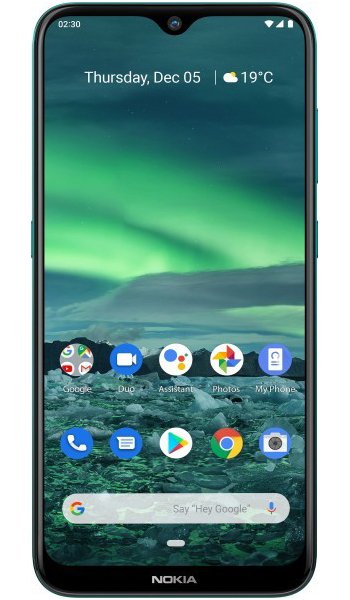Motorola Moto E (2020) vs Nokia 2.3 Comparison and Differences
Smartphone 1
-571.jpg)
Motorola Moto E (2020)
Smartphone 2

Nokia 2.3
Smartphone 3
Motorola Moto E (2020) or Nokia 2.3 Specs Comparison
or
 Common specs
Common specs
| Brand and model | Motorola Moto E (2020) | Nokia 2.3 | |
| Rating | (+0) | (+0) | |
| Release date | 2020, June 05 | 2019, December | |
| Dimensions (HxWxD) | 159.8 x 76.6 x 8.7 mm | 6.29 x 6.29 x 3.02 in | 157.7 x 75.4 x 8.7 mm | 6.21 x 6.21 x 2.97 in | |
| Weight | 185 g | 6.53 oz | 183 g | 6.46 oz | |
| Body Build | Glass front, plastic back, plastic frame | Glass front, plastic back, plastic frame | |
| Case | buy from Amazon | buy from Amazon | |
| Colors | Midnight Blue | Cyan Green, Sand, Charcoal | |
| Battery | 3550 mAh, Non-removable Li-Po | 4000 mAh, Non-removable Li-Po | |
| Approximate price | 130 EUR | 110 EUR | |
| Check price | from Amazon | from Amazon |
 Screen
Screen
| Technology | IPS LCD | IPS LCD | |
| Touchscreen | capacitive touchscreen | capacitive touchscreen | |
| Display colors | 16M | 16M | |
| Screen size | 6.2" in | 6.2" in | |
| Screen area | 95.9 cm2 | 95.9 cm2 | |
| Screen format | 19:9 (height:width) | 19:9 (height:width) | |
| Screen to body ratio | 78.4% | 80.7% | |
| Screen resolution | 720 x 1520 px | 720 x 1520 px | |
| Screen PPI /points per inch/ | 271 PPI | 271 PPI | |
| Other specs | - Always-on display | ||
| Screen protector | buy from Amazon | buy from Amazon |
 Camera and Video
Camera and Video
| Rear camera, main | 13 MP, Dual | 13 MP, Dual | |
| Camera specs | -13 MP, f/2.0, 1/3.1'', 1.12µm, PDAF -2 MP, f/2.2, (depth) |
-13 MP, f/2.2, 1/3.1", 1.12µm, AF -2 MP, 1/5.0", 1.75µm, depth sensor |
|
| Functions | LED flash, HDR, panorama | LED flash, HDR, panorama | |
| Video | 1080p@30/60fps | 1080p@30fps | |
| Front camera, selfie | 5 MP, Single | 5 MP, Single | |
| Specifications | 5 MP, f/2.0, 1.12µm | 5 MP, f/2.4 | |
| Functions | HDR | ||
| Video | 1080p@30fps |
 Performance
Performance
| Operating system - OS | Android 10 | Android 9.0 (Pie), planned upgrade to Android 10; Android One | |
| Chipset | - Qualcomm SDM632 Snapdragon 632 (14 nm) | - Mediatek MT6761 Helio A22 (12 nm) | |
| CPU | - Octa-core (4x1.8 GHz Kryo 250 Gold & 4x1.8 GHz Kryo 250 Silver) | - Quad-core 2.0 GHz Cortex-A53 | |
| GPU | Adreno 506 | PowerVR GE8320 | |
| External memory | microSDXC (dedicated slot) | microSD, up to 512 GB | |
| Internal memory | 32GB 2GB RAM | 32GB 2GB RAM |
 Benchmark
Benchmark
| Antutu 8 Total | 116859 | ||
| Antutu 7 Total | |||
| GeekBench 5 Single Core | 105 | ||
| GeekBench 5 Multi-Core | 402 |
 Communication and Connectivity
Communication and Connectivity
| SIM card | Nano-SIM | Single SIM (Nano-SIM) or Hybrid Dual SIM (Nano-SIM, dual stand-by) | |
| Network | GSM / CDMA / HSPA / EVDO / LTE | GSM / HSPA / LTE | |
| Bands | -2G - GSM 850 / 900 / 1800 / 1900 CDMA 800 / 1900 -3G - HSDPA 850 / 900 / 1700(AWS) / 1900 / 2100 CDMA2000 1xEV-DO -4G - 1, 2, 3, 4, 5, 7, 8, 12, 13, 14, 17, 25, 26, 30, 66, 71 |
-2G - GSM 850 / 900 / 1800 / 1900 - SIM 1 & SIM 2 (Dual SIM model only) GSM 900 / 1800 / 850 - India -3G - HSDPA 850 / 900 / 2100 - Global HSDPA 850 / 900 / 1700(AWS) / 1900 / 2100 - USA / LATAM -4G - LTE band 1(2100), 3(1800), 5(850), 7(2600), 8(900), 20(800), 28(700), 38(2600), 40(2300), 41(2500) - Global |
|
| Speed | HSPA 42.2/5.76 Mbps, LTE | HSPA 42.2/5.76 Mbps, LTE Cat4 150/50 Mbps | |
| GPRS | Yes | Yes | |
| Edge | Yes | Yes | |
| Wi-Fi | Wi-Fi 802.11 a/b/g/n, dual-band, hotspot | Wi-Fi 802.11 b/g/n, hotspot | |
| GPS | Yes, with A-GPS, GLONASS, GALILEO, LTEPP, SUPL | Yes, with A-GPS, GLONASS, BDS | |
| NFC | |||
| USB | microUSB 2.0 | microUSB 2.0, USB On-The-Go | |
| Bluetooth | 4.2, A2DP, LE | 5.0, A2DP, LE | |
| Harmful irradiation |
SAR - 0.81 W/kg (head) 0.86 W/kg (body) SAR EU - 0.41 W/kg (head) 1.40 W/kg (body) |
 Music and Audio
Music and Audio
| Radio | FM radio | FM radio | |
| Headphone jack | Yes | Yes | |
| Others | - Active noise cancellation with dedicated mic |
 Other features
Other features
| Sensors | - Fingerprint (rear-mounted), accelerometer, proximity, compass | - Accelerometer, proximity | |
| Other extras |
- Splash resistant |
Reviews and Opinions on Motorola Moto E (2020) and Nokia 2.3
If you had to recommend one of these phones to a friend, which one would it be and why? Share your arguments using the Add Opinion button!
